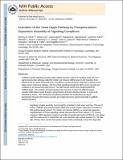| dc.contributor.author | Lim, Daniel Cham-Chin | |
| dc.contributor.author | Stach, Lasse | |
| dc.contributor.author | Ogrodowicz, Roksana W. | |
| dc.contributor.author | Keck, Jamie M. | |
| dc.contributor.author | Jones, Michele H. | |
| dc.contributor.author | Wong, Catherine C. L. | |
| dc.contributor.author | Yates, John R., III | |
| dc.contributor.author | Winey, Mark | |
| dc.contributor.author | Smerdon, Stephen J. | |
| dc.contributor.author | Rock, Jeremy Michael | |
| dc.contributor.author | Yaffe, Michael B | |
| dc.contributor.author | Amon, Angelika B | |
| dc.date.accessioned | 2014-02-28T18:07:40Z | |
| dc.date.available | 2014-02-28T18:07:40Z | |
| dc.date.issued | 2013-04 | |
| dc.date.submitted | 2013-01 | |
| dc.identifier.issn | 0036-8075 | |
| dc.identifier.issn | 1095-9203 | |
| dc.identifier.uri | http://hdl.handle.net/1721.1/85195 | |
| dc.description.abstract | Scaffold-assisted signaling cascades guide cellular decision-making. In budding yeast, one such signal transduction pathway called the mitotic exit network (MEN) governs the transition from mitosis to the G1 phase of the cell cycle. The MEN is conserved and in metazoans is known as the Hippo tumor-suppressor pathway. We found that signaling through the MEN kinase cascade was mediated by an unusual two-step process. The MEN kinase Cdc15 first phosphorylated the scaffold Nud1. This created a phospho-docking site on Nud1, to which the effector kinase complex Dbf2-Mob1 bound through a phosphoserine-threonine binding domain, in order to be activated by Cdc15. This mechanism of pathway activation has implications for signal transmission through other kinase cascades and might represent a general principle in scaffold-assisted signaling. | en_US |
| dc.description.sponsorship | National Institutes of Health (U.S.) (GM056800) | en_US |
| dc.description.sponsorship | National Institutes of Health (U.S.) (CA112967) | en_US |
| dc.description.sponsorship | National Institutes of Health (U.S.) (ES015339) | en_US |
| dc.description.sponsorship | National Science Foundation (U.S.) (Predoctoral Fellowship) | en_US |
| dc.language.iso | en_US | |
| dc.publisher | American Association for the Advancement of Science (AAAS) | en_US |
| dc.relation.isversionof | http://dx.doi.org/10.1126/science.1235822 | en_US |
| dc.rights | Creative Commons Attribution-Noncommercial-Share Alike | en_US |
| dc.rights.uri | http://creativecommons.org/licenses/by-nc-sa/4.0/ | en_US |
| dc.source | PMC | en_US |
| dc.title | Activation of the Yeast Hippo Pathway by Phosphorylation-Dependent Assembly of Signaling Complexes | en_US |
| dc.type | Article | en_US |
| dc.identifier.citation | Rock, J. M., D. Lim, L. Stach, R. W. Ogrodowicz, J. M. Keck, M. H. Jones, C. C. L. Wong, et al. “Activation of the Yeast Hippo Pathway by Phosphorylation-Dependent Assembly of Signaling Complexes.” Science 340, no. 6134 (May 17, 2013): 871–875. | en_US |
| dc.contributor.department | Massachusetts Institute of Technology. Department of Biology | en_US |
| dc.contributor.department | Koch Institute for Integrative Cancer Research at MIT | en_US |
| dc.contributor.mitauthor | Rock, Jeremy M. | en_US |
| dc.contributor.mitauthor | Lim, Daniel Cham-Chin | en_US |
| dc.contributor.mitauthor | Yaffe, Michael B. | en_US |
| dc.contributor.mitauthor | Amon, Angelika B. | en_US |
| dc.relation.journal | Science | en_US |
| dc.eprint.version | Author's final manuscript | en_US |
| dc.type.uri | http://purl.org/eprint/type/JournalArticle | en_US |
| eprint.status | http://purl.org/eprint/status/PeerReviewed | en_US |
| dspace.orderedauthors | Rock, J. M.; Lim, D.; Stach, L.; Ogrodowicz, R. W.; Keck, J. M.; Jones, M. H.; Wong, C. C. L.; Yates, J. R.; Winey, M.; Smerdon, S. J.; Yaffe, M. B.; Amon, A. | en_US |
| dc.identifier.orcid | https://orcid.org/0000-0002-9547-3251 | |
| dc.identifier.orcid | https://orcid.org/0000-0001-9837-0314 | |
| mit.license | OPEN_ACCESS_POLICY | en_US |
| mit.metadata.status | Complete | |
